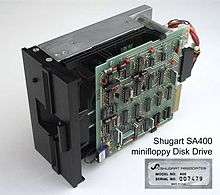Shugart Associates
|
| |
| Industry | Computer hardware |
|---|---|
| Founded | 1973 |
Area served | Worldwide |
Key people | Alan Shugart (Founder) |
| Products | Floppy disk drives |
Shugart Associates was a computer peripheral manufacturer that dominated the floppy disk drive market in the late 1970s and is famous for introducing the 5 1⁄4-inch minifloppy floppy disk drive.
Founded in 1973, Shugart Associates was purchased by Xerox in 1977. In the early 1980s the name was changed to Shugart Corporation. Xerox exited the business in 1985 and 1986, selling the brand name and the 8-inch floppy product line to Narlinger Group (in March 1986). Narlinger promptly rebranded itself as Shugart Corporation and continued as such into the early 1990s. Under Narlinger management, Shugart acquired several discontinued product lines such as the Optotech 5984 Write Once Read Many (WORM) drive.
History
Alan Shugart, after a distinguished career at IBM and a few years at Memorex, decided to strike out on his own, and in 1973 he gathered up some venture capital and started Shugart Associates. The original business plan was to build a small-business system (similar to the IBM 3740[1]) including the development of all of the major components, including floppy disk drives, a printer, etc. After two years the seed money was gone and Shugart had no product to show for it. The Board wanted to focus on the floppy disk drive but Shugart wanted to continue the original plan. Official company documents state that Shugart quit, but he tells the story another way, that he was fired by the venture capitalists. Shugart went on with Finis Conner to found Shugart Technology in 1979, whose name was changed to Seagate Technology in response to a legal challenge by Xerox.

The 5 1⁄4-inch disk drive was developed by Shugart in 1976.
The minifloppy (Shugart's trademarked brand name) was introduced in September 1976[2] as the SA-400 at an OEM price of $390 for the drive and $45 for ten diskettes.[3] The SA-400 and related models became their best selling products, with shipments of up to 4000 drives per day.
The original SA-400 was single-sided and supported 35-track formatting. It could be used on either a hard or soft-sector floppy controller and was rated at 85k (with a single-density controller) or 110k (with a double-density controller). The drive became the basis of the disk system on the Apple II and many other early microcomputers.
In the early 1980s, in order to avoid development and start-up costs, the company turned to Matsushita Communications Inc., a subsidiary of Matsushita, for its half-height 5 1⁄4-inch drives, starting that company on its way to becoming the largest floppy drive manufacturer in the world. In 1985, in order to resolve an inventory accumulation and as part of its exit strategy, Xerox gave up Shugart's exclusive rights to the Matsushita half-height 5 1⁄4-inch floppy disk drives. Shugart's downfall partially came about as a result of the company failing to develop a reliable 80-track disk drive.
In 1979, Shugart Associates introduced the "Shugart Associates System Interface" (SASI) to the computing world; the interface subsequently evolved into SCSI (Small Computer System Interface), and has gone on to change the face of storage. The first standard process completed in 1986 with ANSI standard X3.131-1986 (popularly known as SCSI-1) as the result.
Larry Boucher led the SASI engineering team; he and several of the engineers who worked on SASI left in 1981 to found host adapter maker Adaptec.
References
- ↑ IBM 3740 IBM Archives
- ↑ Sollman, G. Evolution of the minifloppy (TM) product family IEEE Transactions on Magnetics, Jul 1978.
- ↑ Shugart Adds Minifloppy Drive, Computerworld, Sept 13, 1976, p. 51.
External links
| Wikimedia Commons has media related to Shugart Minifloppy. |